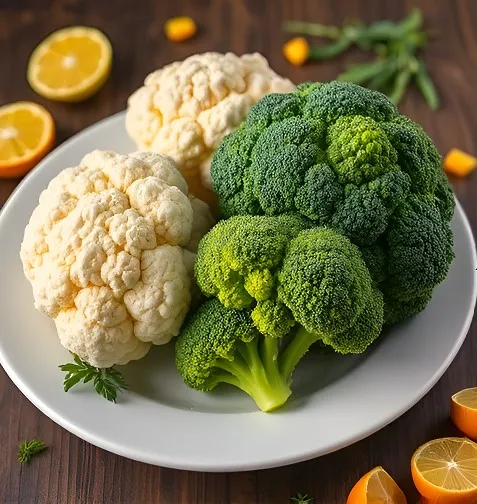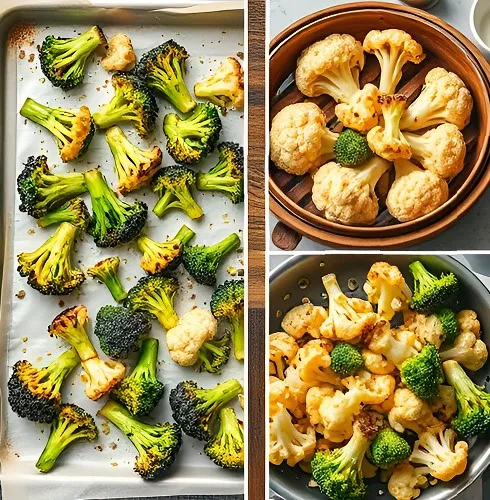There’s something undeniably satisfying about experiencing the crunch of perfectly cooked vegetables. Whether it’s the first bite of a fresh salad or the golden crisp on a roasted platter, vegetables have a way of turning a simple meal into a delightful experience. Today, we’re diving deep into one of the most versatile and nutritious vegetable duos out there—Broccoli and Cauliflower. Not only are they close relatives from the Brassica family, but when paired together, they create a meal that is as visually appealing as it is tasty. In this comprehensive guide, we’ll explore everything from the nutritional benefits of these veggies to multiple cooking methods, pairing ideas, and storage tips. By the end of this post, you’ll be convinced that adding a little broccoli cauliflower magic to your meal plan is a game-changer.
Table of Contents
A Family Reunion on Your Plate
At first glance, broccoli and cauliflower might seem like any ordinary vegetables. However, they boast a fascinating lineage—the same Brassica family that brings us kale, cabbage, and Brussels sprouts. Imagine hosting a family reunion where every relative has unique talents and flavors. That’s the appeal of this duo. When combined in one dish, they deliver varied textures and flavors, each bite offering complexity and a burst of crisp freshness. No more boring steamed greens; this pairing turns everyday vegetables into a celebration of taste, color, and health.

Why Broccoli Cauliflower Stole My Heart
As someone who has experimented with countless vegetable recipes over the years, I can confidently say that broccoli cauliflower is now a staple in my kitchen. Here are a few reasons why:
- Texture Perfection:
There’s a fine line between perfectly cooked vegetables and mushy disappointment. In this dish, both broccoli and cauliflower retain their natural bite and crunch. That slight “snap” when you bite in is a reminder that you’re enjoying them at just the right state of tenderness. - Nutritional Powerhouse:
Packed with vitamins C and K, fiber, and phytonutrients, broccoli and cauliflower together create a high-energy, low-calorie side dish. Pairing them elevates your meal, supports immune function, and promotes healthy digestion—all without sacrificing flavor. - Budget-Friendly and Accessible:
Fresh produce can sometimes break the bank, but luckily broccoli and cauliflower are often very affordable, especially when they’re in season. They’re easy to find at your local market, making it simple to integrate them into your weekly meal planning. - Versatility Meets Creativity:
One of the best aspects about this dish is how easily it adapts to your tastes. Whether you’re in a mood for a little zing from lemon juice, a sprinkle of Parmesan, or even a warming kick from red pepper flakes, broccoli cauliflower is a blank canvas ready for your culinary creativity.
Nutritional Benefits: Fueling Your Body the Delicious Way
Before we get into the nuts and bolts of preparing this dish, it’s important to understand why broccoli and cauliflower deserve a top spot on your plate. Here’s a quick rundown of their health benefits:
- Broccoli:
Known for its impressive nutrient profile, broccoli is loaded with vitamins C, K, and A, as well as folate and fiber. It also contains sulforaphane, a compound renowned for its potential to reduce inflammation and protect against certain cancers. - Cauliflower:
Often celebrated as a low-carb substitute in many modern recipes, cauliflower is rich in fiber and vitamin C. It supports heart health and is known for its anti-inflammatory properties. Its neutral flavor also means it readily absorbs the flavors of any seasoning you add.
Together, these vegetables not only complement each other in taste and texture but also provide a balanced array of nutrients essential for a healthy lifestyle.
What Exactly is Broccoli Cauliflower?
You might be wondering, “Broccoli cauliflower? Is that some futuristic hybrid vegetable?” The answer is pleasantly simple. It’s not a new invention or a secret lab creation—it’s simply a dish that celebrates the natural combination of broccoli and cauliflower. Whether you roast, steam, or sauté them, the goal is to preserve their inherent flavors while adding a little extra punch from your preferred seasonings. This isn’t a case of overcomplicating a meal; it’s about embracing the seasonal harmony of these vegetables and letting their natural profiles shine.
Exploring the Different Cooking Methods
One of the reasons I’m so passionate about the broccoli cauliflower dish is its remarkable adaptability. There isn’t a one-size-fits-all approach here—you can adjust this recipe to fit your schedule, your taste buds, and even your kitchen equipment. Let’s explore the three most popular methods for preparing this delightful dish.

Method 1: Roasted Broccoli Cauliflower
Roasting vegetables is one of my favorite ways to bring out their natural sugars and flavors. The slow caramelization not only intensifies their taste but also gives each floret a tantalizing crispness.
Quick Overview:
- Preheat your oven to 400°F (200°C).
- Prepare your vegetables by washing them thoroughly, then cutting the broccoli into bite-sized florets and doing the same with the cauliflower.
- Drizzle with olive oil and sprinkle in minced garlic, salt, and pepper.
- Arrange them in a single layer on a baking sheet lined with parchment paper.
- Roast for 20-25 minutes, tossing halfway through for even cooking.
- Once they’re tender-crisp and slightly browned, remove them from the oven and add your favorite garnishes—lemon wedges, Parmesan, or red pepper flakes.
Why Roasting Works Wonders:
Roasting brings out a rich, robust flavor that steamed or sautéed methods can’t quite replicate. The edges of the florets become beautifully charred—a reminder of that irresistible crunch—while the inside remains soft enough to carry the subtle flavor of garlic and herbs. It’s a simple way to elevate your meal with minimal effort.
Tips for Perfect Roasting:
- Even Cutting: Ensure that all florets are roughly the same size. Uneven pieces may lead to some parts being undercooked while others crisp up too much.
- Avoid Overcrowding: Spread the vegetables out. Overcrowding leads to steaming rather than roasting.
- Tossing for Uniformity: Give the pan a good shake halfway through cooking to redistribute the heat evenly.
Method 2: Steamed Broccoli Cauliflower
Steaming is a fantastic way to preserve as many nutrients as possible while keeping the natural flavors vibrant and fresh. For those who prefer a lighter option that still delivers on texture, this method is ideal.
Quick Overview:
- Begin by washing and cutting your vegetables into uniform florets.
- Place them in a steamer basket positioned in a saucepan with about an inch of water.
- Bring the water to a boil, then let the vegetables steam for 8-10 minutes until they are tender yet retain a satisfying crispness.
- Remove them from the steamer and toss with olive oil, garlic, salt, and pepper.
- Garnish with lemon juice or fresh herbs for an extra layer of flavor.
Why Steaming is Special:
One of the biggest advantages of steaming is nutrient retention. Vitamins such as C are sensitive to heat, and steaming minimizes nutrient loss. Additionally, steaming maintains the integrity of the vegetables, ensuring that each bite delivers the full natural taste without the interference of caramelization.
Tips for Steaming Success:
- Water Level: Make sure there’s enough water in the pan, but not so much that the vegetables are submerged.
- Cover Tightly: Use a lid to trap the steam, which helps the vegetables cook evenly.
- Monitor Closely: Since steaming is a quick process, keep an eye on the time to avoid overcooking.
Method 3: Sautéed Broccoli Cauliflower
Sautéing offers another fantastic way to cook these vegetables quickly, preserving both their crunch and natural flavor while integrating aromatic ingredients like garlic. This method is perfect when you need a nutritious side dish in a hurry.
Quick Overview:
- Wash and cut your broccoli and cauliflower into equal-sized florets.
- Heat olive oil in a large skillet over medium heat.
- Add minced garlic and sauté for roughly 30 seconds until fragrant—be cautious not to let it burn.
- Toss in the vegetables and sauté them for about 10-12 minutes. Stir frequently to ensure even cooking.
- Season with salt and pepper. If necessary, add a splash of water to prevent sticking.
- Serve immediately with your chosen garnishes.
Why Sautéing is a Great Option:
Sautéing is a cook’s best friend because it allows for quick flavor infusion. Garlic and oil combine to coat each piece of broccoli and cauliflower, while the rapid cooking process ensures that the vegetables do not lose their vital crunch. It’s a method that results in a dish bursting with flavor and texture complexity.
Tips for Sautéing to Perfection:
- Preheat Your Pan: Ensure the skillet is hot before adding the oil for a quick sear.
- Keep it Moving: Stir the vegetables continuously to promote even cooking.
- Don’t Rush the Garlic: Introduce garlic only when the oil is ready, and remove it if it starts to brown too much to avoid bitterness.
Enhancing the Flavor: Creative Twists and Garnishes
The beauty of a broccoli cauliflower dish lies in its flexibility to absorb different flavors, making it a true canvas for culinary creativity. Here are some ideas to personalize your dish:
- Cheese It Up: A sprinkle of grated Parmesan or pecorino can elevate the dish, adding a savory depth that pairs beautifully with both roasted and sautéed methods.
- Zesty Lemon: A squeeze of lemon or a sprinkle of lemon zest brightens the flavors significantly, balancing the slight bitterness of the vegetables.
- Heat It Up: Red pepper flakes or a dash of hot sauce can add a pleasant warmth, especially when the dish is served as part of a hearty meal.
- Herbal Infusions: Fresh herbs like parsley, thyme, rosemary, or basil not only add color but also contribute a refreshing aroma that complements the earthy tones of broccoli and cauliflower.
- Nutritional Extras: For an extra nutrient boost, consider tossing in some toasted almonds, walnuts, or even a handful of dried cranberries once the dish is served.
Experimenting with these additions can transform a simple side dish into a centerpiece that rivals more complex recipes.

Pairing Broccoli Cauliflower with Main Courses
While broccoli cauliflower shines as a standalone side, its versatility makes it a welcome partner to a variety of main dishes. Here are some pairing ideas to inspire your next meal:
- Grilled Chicken & Fish: The brightness of the broccoli cauliflower complements the smoky flavors of grilled proteins like chicken breast or salmon. The crunch provides a perfect textural contrast to the tender meat.
- Roasted Pork Tenderloin: The robust flavors of a well-seasoned pork tenderloin pair exceptionally with the mellow earthiness of these vegetables. The slight char from roasting the veggies balances the savory richness of the meat.
- Vegetarian Feasts: Serve this dish alongside hearty vegetarian entrées such as lentil soup, chickpea curry, or a savory vegetarian lasagna. The combination provides a balanced meal full of protein, fiber, and essential nutrients.
- Pasta Dishes: Integrate roasted broccoli and cauliflower into a pasta dish for added texture and nutritional value. Toss them into a creamy Alfredo or a vibrant tomato sauce—either way, you get an extra boost of vitamins and antioxidants.
- Grain Bowls: Combine with your favorite whole grains (quinoa, farro, or brown rice) and a drizzle of tahini or balsamic glaze for a nutrient-packed bowl that’s as filling as it is flavorful.
These pairing ideas offer a glimpse into the endless possibilities that broccoli cauliflower brings to the table. Whether you’re cooking for one or feeding a family, these vegetables can seamlessly complement any main course.
The Essential Tips for Perfect Broccoli Cauliflower Every Time
Cooking vegetables to perfection might seem simple, but there are a few crucial tips that can transform your dish from good to extraordinary. Here are some insights gathered from years of kitchen experiments:
- Avoid Overcooking:
One common pitfall is cooking the vegetables too long, leading to a soggy and unappetizing texture. Aim for “tender-crisp”—that sweet spot where the vegetables are soft enough to chew but still maintain their crunch. Testing with a fork frequently is the key. - Uniform Sizing is Crucial:
Cutting your broccoli and cauliflower into similar-sized florets ensures even cooking. This is especially critical when roasting or sautéing because uneven pieces may cook at different rates, resulting in some bits being overdone while others remain undercooked. - Do Not Overcrowd the Pan:
Whether you’re roasting or sautéing, giving each floret space is essential. Overcrowding can lead to steaming rather than browning. Spread the vegetables in a single layer on your baking sheet or skillet for maximum crispness. - Experiment with Herbs and Spices:
Don’t be afraid to try different seasonings. A pinch of red pepper flakes can add subtle heat, while dried thyme or rosemary can bring an aromatic depth to your dish. The secret is to trust your palate and adjust the seasonings throughout the cooking process. - Refresh with Acid:
A splash of lemon juice or a drizzle of vinegar right at the end of cooking can lift the overall flavor profile. The acid balances the natural bitterness of the vegetables and adds brightness to the dish. - Consider Oil Quality and Temperature:
The type of oil and its temperature when cooking can make a significant difference. Using a good quality olive oil adds a fruity note, and ensuring that your oil is hot enough right away helps sear the vegetables effectively, locking in flavor and crunch.
Storing, Reheating, and Even Freezing Your Veggie Dish
Sometimes, despite our best culinary efforts, we end up with leftovers. Knowing how to properly store and reheat broccoli cauliflower can be a lifesaver on busy days.
- Storing:
Once your dish has cooled to room temperature, transfer any leftovers to an airtight container. The dish can be kept in the refrigerator for 3-4 days. Keeping it covered helps maintain the vegetables’ moisture and prevents them from absorbing unwanted odors. - Reheating:
For the best texture, reheat the vegetables using one of the following methods:- Oven Method:
Preheat your oven to 350°F (175°C) and spread the vegetables on a baking sheet. Roast for 5-7 minutes to refresh the crispness. - Sautéing:
A quick toss in a hot skillet with a splash of olive oil works well. This method is especially effective if you want to maintain the veggies’ snap. - Microwave:
If time is of the essence, you can use the microwave. Place the vegetables in a microwave-safe dish, cover loosely, and heat for about 1-2 minutes. Note that microwaving can sometimes soften the crisp texture, so consider following up with a quick pan sauté if needed.
- Oven Method:
- Freezing:
Although freezing can slightly alter the texture, it’s a viable option for long-term storage. To freeze cooked broccoli cauliflower:- Step 1: Spread the vegetables in a single layer on a baking sheet.
- Step 2: Freeze for about an hour so they freeze individually without clumping.
- Step 3: Transfer the frozen vegetables to a freezer bag or airtight container. They can be stored for up to 2-3 months.
- Step 4: When ready to eat, reheat directly from frozen, allowing a few extra minutes for the dish to warm evenly.
Beyond the Basics: Creative Variations and Meal Inspirations
Once you’ve mastered the basics of roasting, steaming, or sautéing broccoli cauliflower, consider some of these creative variations to keep your veggie routine exciting:
- Broccoli Cauliflower Gratin:
Combine your roasted florets with a light béchamel sauce, sprinkle a generous amount of cheese, and bake until bubbly and golden. This adaptation turns a simple side dish into a hearty, comforting meal perfect for chilly evenings. - Broccoli Cauliflower Salad:
For a refreshing twist, cool your steamed broccoli cauliflower and toss it with a tangy vinaigrette, chopped nuts, seeds, and dried cranberries. Serve as a nutritious side salad or even as a light lunch. - Spiced Vegetable Medley:
Add a touch of cumin, coriander, and turmeric while sautéing for a vibrant, spiced version that pairs wonderfully with rice or quinoa. Top with a handful of fresh cilantro to complete the flavor profile. - Fusion-Style Wraps:
Use roasted broccoli cauliflower as a filling for wraps or burritos. Layer with a protein of your choice, add some avocado slices, and drizzle with a yogurt-based sauce for a satisfying, portable meal.
These creative twists illustrate just how adaptable this vegetable duo can be. The flexibility to fit different cuisines and meal types makes broccoli cauliflower a worthy investment in both your health and culinary exploration.
Bringing It All Together: A Final Thought on the Veggie Power Couple
Broccoli and cauliflower might be humble vegetables, but when treated with respect and a bit of culinary flair, they transform ordinary meals into extraordinary experiences. From the moment you slice them into uniform pieces to that satisfying crunch with every bite, the process of preparing and enjoying broccoli cauliflower is both a practical and artful practice. This isn’t just about eating vegetables—it’s about treating your body to something wholesome while indulging in flavors that satisfy the palate.
Cooking healthily doesn’t have to mean sacrificing taste. By following these methods and tips, you can be confident that even the pickiest eaters in your household will be reaching for seconds. Whether you’re a busy parent, a health enthusiast, or simply someone who loves to experiment in the kitchen, this broccoli cauliflower guide is your roadmap to delicious, nutritious dining.
In Conclusion
With over two millennia of combined culinary wisdom and modern nutritional science backing up the benefits of eating vegetables, it’s time to give broccoli and cauliflower the spotlight they deserve. They aren’t merely a side dish or a healthy filler—they are a celebration of nature’s bounty. By incorporating this versatile dish into your meal plan, you’re not just making a delicious choice; you’re making a powerful commitment to your well-being.

